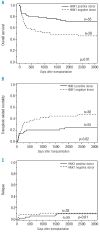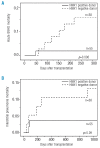NKG2D gene polymorphism has a significant impact on transplant outcomes after HLA-fully-matched unrelated bone marrow transplantation for standard risk hematologic malignancies
- PMID: 19794085
- PMCID: PMC2754959
- DOI: 10.3324/haematol.2009.008318
NKG2D gene polymorphism has a significant impact on transplant outcomes after HLA-fully-matched unrelated bone marrow transplantation for standard risk hematologic malignancies
Abstract
Background: NKG2D, an activating and co-stimulatory receptor expressed on natural killer cells and T cells, plays pivotal roles in immunity to microbial infections as well as in cancer immunosurveillance. This study examined the impact of donor and recipient polymorphisms in the NKG2D gene on the clinical outcomes of patients undergoing allogeneic T-cell-replete myeloablative bone marrow transplantation using an HLA-matched unrelated donor.
Design and methods: The NKG2D polymorphism was retrospectively analyzed in a total 145 recipients with hematologic malignancies and their unrelated donors. The patients underwent transplantation following myeloablative conditioning; the recipients and donors were matched through the Japan Marrow Donor Program.
Results: In patients with standard-risk disease, the donor NKG2D-HNK1 haplotype, a haplotype expected to induce greater natural killer cell activity, was associated with significantly improved overall survival (adjusted hazard ratio, 0.44; 95% confidence interval, 0.23 to 0.85; p=0.01) as well as transplant related mortality (adjusted hazard ratio, 0.42; 95% confidence interval, 0.21 to 0.86; p=0.02), but had no impact on disease relapse or the development of grade II-IV acute graft-versus-host disease or chronic graft-versus-host disease. The NKG2D polymorphism did not significantly influence the transplant outcomes in patients with high-risk disease.
Conclusions: These data suggest an association between the donor HNK1 haplotype and better clinical outcome among recipients, with standard-risk disease, of bone marrow transplants from HLA-matched unrelated donors.
Figures



Similar articles
-
Improved survival with inhibitory killer immunoglobulin receptor (KIR) gene mismatches and KIR haplotype B donors after nonmyeloablative, HLA-haploidentical bone marrow transplantation.Biol Blood Marrow Transplant. 2010 Apr;16(4):533-42. doi: 10.1016/j.bbmt.2009.11.022. Epub 2009 Dec 2. Biol Blood Marrow Transplant. 2010. PMID: 19961944 Free PMC article. Clinical Trial.
-
Genetic variants of human granzyme B predict transplant outcomes after HLA matched unrelated bone marrow transplantation for myeloid malignancies.PLoS One. 2011;6(8):e23827. doi: 10.1371/journal.pone.0023827. Epub 2011 Aug 23. PLoS One. 2011. PMID: 21886827 Free PMC article.
-
Superior survival associated with transplantation of matched unrelated versus one-antigen-mismatched unrelated or highly human leukocyte antigen-disparate haploidentical family donor marrow grafts for the treatment of hematologic malignancies: establishing a treatment algorithm for recipients of alternative donor grafts.Blood. 2002 Feb 1;99(3):806-14. doi: 10.1182/blood.v99.3.806. Blood. 2002. PMID: 11806980
-
Bone marrow transplantation for chronic myeloid leukemia with volunteer unrelated donors using ex vivo or in vivo T-cell depletion: major prognostic impact of HLA class I identity between donor and recipient.Blood. 1995 Nov 1;86(9):3590-7. Blood. 1995. PMID: 7579468 Review.
-
Effect of HLA incompatibility in marrow transplantation from unrelated and HLA-mismatched related donors.Transfus Sci. 1994 Sep;15(3):221-30. doi: 10.1016/0955-3886(94)90134-1. Transfus Sci. 1994. PMID: 10155543 Review.
Cited by
-
Infection Complications in Hematopoietic Stem Cells Transplant Recipients: Do Genetics Really Matter?Front Microbiol. 2018 Oct 2;9:2317. doi: 10.3389/fmicb.2018.02317. eCollection 2018. Front Microbiol. 2018. PMID: 30356925 Free PMC article. Review.
-
Single-Nucleotide Polymorphisms in MICA and MICB Genes Could Play a Role in the Outcome in AML Patients after HSCT.J Clin Med. 2021 Oct 9;10(20):4636. doi: 10.3390/jcm10204636. J Clin Med. 2021. PMID: 34682758 Free PMC article.
-
The Impact of NLRP3 Activation on Hematopoietic Stem Cell Transplantation.Int J Mol Sci. 2021 Oct 31;22(21):11845. doi: 10.3390/ijms222111845. Int J Mol Sci. 2021. PMID: 34769275 Free PMC article. Review.
-
The Host-Microbe Interplay in Human Papillomavirus-Induced Carcinogenesis.Microorganisms. 2019 Jul 13;7(7):199. doi: 10.3390/microorganisms7070199. Microorganisms. 2019. PMID: 31337018 Free PMC article. Review.
-
Recipient ADAMTS13 Single-Nucleotide Polymorphism Predicts Relapse after Unrelated Bone Marrow Transplantation for Hematologic Malignancy.Int J Mol Sci. 2019 Jan 8;20(1):214. doi: 10.3390/ijms20010214. Int J Mol Sci. 2019. PMID: 30626079 Free PMC article.
References
-
- Weisdorf DJ, Anasetti C, Antin JH, Kernan NA, Kollman C, Snyder D, et al. Allogeneic bone marrow transplantation for chronic myelogenous leukemia: comparative analysis of unrelated versus matched sibling donor transplantation. Blood. 2002;99:1971–7. - PubMed
-
- Gratwohl A, Brand R, Frassoni F, Rocha V, Niederwieser D, Reusser P, et al. Cause of death after allogeneic haematopoietic stem cell transplantation (HSCT) in early leukaemias: an EBMT analysis of lethal infectious complications and changes over calendar time. Bone Marrow Transplant. 2005;36:757–69. - PubMed
-
- Dickinson AM, Middleton PG, Rocha V, Gluckman E, Holler E. Genetic polymorphisms predicting the outcome of bone marrow transplants. Br J Haematol. 2004;127:479–90. - PubMed
-
- Elmaagacli AH, Koldehoff M, Landt O, Beelen DW. Relation of an inter-leukin-23 receptor gene polymorphism to graft-versus-host disease after hematopoietic-cell transplantation. Bone Marrow Transplant. 2008;41:821–6. - PubMed
Publication types
MeSH terms
Substances
LinkOut - more resources
Full Text Sources
Medical
Research Materials

